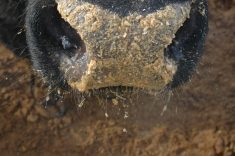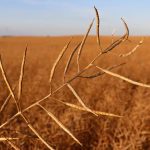By Mark Weinraub
FARGO, North Dakota, July 25 (Reuters) – Prospects for the 2013 U.S. hard red spring wheat crop are about in line with 2012, but unlike last year, weather over the next month will determine final yields for the late-maturing crop, scouts on an annual crop tour said Thursday.
“A year ago was a very different crop. A year ago, they we’re cutting it. This one has quite a ways to go,” said Dave Green of ADM Milling, one of the tour’s leaders.
Scouts on the Wheat Quality Council’s three-day tour surveyed 433 spring wheat fields and 31 durum wheat fields in North Dakota and adjacent areas of Minnesota and South Dakota.
Read Also

U.S. grains: Soy, corn futures weaken on harvest pressure, firm dollar
Chicago | Reuters – U.S. soybean and corn futures fell on Thursday on seasonal pressure as the harvest expanded in…
The tour projected the spring wheat yield at 44.9 bushels per acre, matching its 2012 forecast and up 3.7 percent from the tour’s prior five-year average of 43.3 bushels per acre.
For durum wheat, the tour calculated an average yield of 41.7 bushels per acre, down from 42.4 in 2012.
The tour also scouted eight fields of hard red winter wheat and calculated an average yield of 53.5 bushels per acre.
Wet weather delayed spring planting in much of the United States, and crops are developing more slowly than normal in North Dakota, which produces almost half of all U.S. spring and durum wheat. The crop’s immaturity leaves it vulnerable to stressful weather ahead of harvest, which is up to six weeks away for some fields.
The U.S. Department of Agriculture said 82 percent of the North Dakota spring wheat crop had reached the heading phase by July 21, lagging the five-year average of 88 percent.
“The next 30 days really hold the key to this crop,” said Carrol Duerr, general manager of Colfax Farmers Elevator and a scout on the tour. Duerr said he was surprised by the variance in crop maturity between fields just a few miles apart, particularly in the north.
Acreage left fallow also was not uniform, Duerr added. The empty fields, mostly scattered across the state’s northern tier, were often adjacent to acres that farmers did manage to plant.
The crop will need to avoid hot temperatures in August which could hamper grain fill and reduce test weights when the crop is harvested.
“It is a very nice crop. The only problem with this crop is if it gets hot in the next few weeks,” said Ben Handcock, executive vice president of the Wheat Quality Council.
Spring wheat is prized by millers for its high protein content, but it was too soon to say how the current crop would measure up.
“Typically with high-yielders you get low protein, but this one has a chance to be good. It needs a little heat stress, but not too much because that will hurt it,” Handcock said.
Tour scouts noted that spring wheat fields were harder to find than in past years, especially in southern and eastern North Dakota where farmers have been planting more profitable crops such as corn and soybeans.
The USDA has forecast North Dakota’s 2013 spring wheat harvest at 229.6 million bushels, with an average yield of 41 bushels per acre.
Hard red spring wheat, a high-quality grain that is milled into flour for bread and pizza dough, makes up about a quarter of the total U.S. wheat crop. Durum wheat is used to make pasta.
The tour, which departed from Fargo on Tuesday, attracted a record 75 participants including farmers, market analysts, grain buyers, government statisticians and officials from food companies such as Kraft Foods Group Inc and General Mills Inc.













